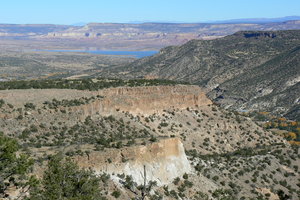Advertisement
Published: October 22nd 2012

 Tsi-p'in-owinge'
Tsi-p'in-owinge'
The ruins are at the top of the mesa. Abiquiu Lake is in the distance, the reservoir created by Abiquiu Dam for Rio Champa, a tributary for Rio Grande.
The Rio Chama, a major tributary of the Rio GrandeWell before dawn on Saturday morning, we began the 75-minute drive to Abiquiu to meet our friend, archeologist Martha Yates. We met Martha two years ago at Ghost Ranch (http://ghostranch.org/ancient-sites-ancient-waters/), where she led our week-long field study class entitled "Ancient Sites, Ancient Waters." She graciously agreed to guide us this year to a site not available during our class: Tsi-p'in-owinge' (Village at Flaking Stone Mountain), a sacred place to the present-day pueblo peoples. Martha obtained the necessary permit to visit the site and drove us in her 20-year-old, four-wheel-drive truck for the hour-long drive over rough roads to the trailhead. A steep trail of switchbacks took us down to a narrow ridge that is part of the ancient trail. From there we crossed a canyon and climbed up to a narrow mesa--a dramatic setting for the ruins of this ancient pueblo.
The small mesa on which Tsi-p'in-owinge' (7,400 ft.) sits has a view of the prominent mountain to the west: Cerro Pedernal (9,870 ft.), made famous by Georgia O'Keefe's paintings. The modern pueblo language of Tewa renders the name of the mountain as Tsi-p'in (Flaking Stone Mountain): Both the Spanish and Tewa names refer to the abundance of a type
of flint stone called chert that was widely used by the pueblo peoples for making tools. The ancient pueblo was built around 1275 A.D. and grew to a population of about 1,000 people. However, it was only used for a few generations, then occupied intermittently by smaller groups until 1450.
At its peak, the pueblo consisted of 1,500 multistory rooms constructed of stone blocks quarried from the volcanic tuff found on the mesa. Abandoned quarry sites were converted to kivas, and numerous other smaller kivas were created by excavating topsoil down to the bedrock. These kivas had roofs built of wooden poles or rafters, topped by bark and then covered by mud. The kivas were used for social and religious gatherings and daily tasks, such as weaving and cooking. One very unusual excavation featured a narrow pit quarried from stone--just wide and high enough for a man to stand. The pit was covered with a roof of thin sticks, and atop it a rabbit was tethered. When an eagle swooped down to clasp the rabbit in its claws, the man hidden in the pit would reach up and capture it. Eagle feathers were prized and used for ceremonial purposes.

 Eagle Trap
Eagle Trap
Martha and her sweet dog, QuenTsi-p'in-owinge was sited according to four cardinal points (North, South, East and West).
As we reached its perimeter, Martha pointed out a small triangular "window" in a block of huge boulders, through which we could view the distinctive flat-topped Cerro Pedernal. A natural hole in the rock had been enlarged so that the top of the triangle could be used at equinox to sight the sun as it set behind Pedernal. In a similar manner, Tsi-p'in-owinge's Great Kiva, the largest in the pueblo, had a mound at both the eastern and western cardinal points, with the west mound oriented toward Pedernal.
Another fascinating feature of the ruins was a large reservoir to store rainwater and snowmelt, created by excavating down to the bedrock--it may have held as much as 700,000 gallons! The people would direct the water through shallow irrigation ditches to their extensive gardens where they grew corn, beans and squash to supplement the food they gathered and hunted. Another food source was domesticated turkeys: turkeys provided not only food but also excellent fertilizer for the gardens. The people transported water from the reservoir or nearby streams and springs using deerskin bags or woven flax baskets lined

 Triangle Window
Triangle Window
Pedernal in the distancewith mud and dried to create watertight containers.
Advertisement
Tot: 0.128s; Tpl: 0.011s; cc: 5; qc: 44; dbt: 0.0407s; 1; m:domysql w:travelblog (10.17.0.13); sld: 1;
; mem: 1.1mb

 Tsi-p'in-owinge'
Tsi-p'in-owinge'
 Eagle Trap
Eagle Trap
 Triangle Window
Triangle Window
